Lions on the Serengeti Plains
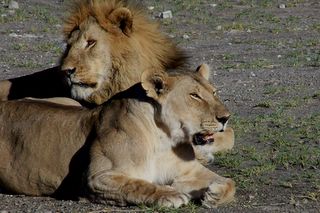 This male and female lion pair live near a stream in the Serengeti, a huge plains area in Tanzania. All types of animals live on the plains and migrate through each year. The plains are a reserve area designated by the Tanzanian government and providing total protection to the animals from hunters. Other lions belong to the pride (family) of the pictured pair. Several prides of lions live in this area. When a lion roars, he or she can be heard from miles away. Imagine what it would sound like if they were just outside your tent?!
This male and female lion pair live near a stream in the Serengeti, a huge plains area in Tanzania. All types of animals live on the plains and migrate through each year. The plains are a reserve area designated by the Tanzanian government and providing total protection to the animals from hunters. Other lions belong to the pride (family) of the pictured pair. Several prides of lions live in this area. When a lion roars, he or she can be heard from miles away. Imagine what it would sound like if they were just outside your tent?!
Wildebeest on Serengeti Plains
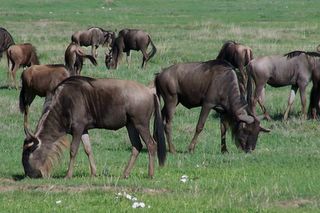 These Wildebeest live on the Serengeti plains in Tanzania, though they migrate northward into Kenya once a year. There are more than one million Wildebeest who move each year. And they all move together. It's quite amazing to see so many animals moving together. You can see the migration on TV on channels like the Disovery channel or Animal Planet.
These Wildebeest live on the Serengeti plains in Tanzania, though they migrate northward into Kenya once a year. There are more than one million Wildebeest who move each year. And they all move together. It's quite amazing to see so many animals moving together. You can see the migration on TV on channels like the Disovery channel or Animal Planet.
Ngorongora Crater, Tanzania
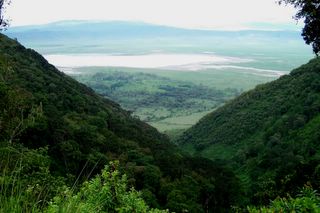 You can see why this gorgeous crater attracts all types of animals. The lake at the bottom provides water. Some of the animals that live here are: elephants, lions, hyenas, warthogs, zebra, waterbucks, Impala, gazelle, cheetah, leopards, hippos and wildebeest. This area is not really a crater. It was once a volcano but has collapsed in on itself over millions of years. Flamingoes live on the lake's edge and create quite a sight when they flock together.
You can see why this gorgeous crater attracts all types of animals. The lake at the bottom provides water. Some of the animals that live here are: elephants, lions, hyenas, warthogs, zebra, waterbucks, Impala, gazelle, cheetah, leopards, hippos and wildebeest. This area is not really a crater. It was once a volcano but has collapsed in on itself over millions of years. Flamingoes live on the lake's edge and create quite a sight when they flock together.
Samuel the Guard (Escary)
 This is the compound where I live in Kisumu, Kenya. The Ruprahs live in the main house and I rent their same house in the back. Samuel is the supervisor of the guards who secure the purple gate in the background. In Kiswahili, the word for guard is "escary," pronounced es-scar-re. Samuel only lets people into the compound who belong here. The gate is usually chained and padlocked. In addition to being the guard, Samuel also keeps the yard clean. You can see in his hand a homemade broom. He has tied pieces of leafy branches to a stick and he uses this to sweep up leaves (see the pile of brown leaves) and seeds that drop from the trees onto the cement.The tree growing in the foreground on the left is a Papaya tree. It's too young to bear fruit, but in a year or two, the tree will be 15 or 20 feet tall. Big, green Papayas will grow in bunches under the top grouping of leaves. The bark forms a beautiful honeycomb pattern when the trees grow up. In Kenya, they call a Papaya a Popo, pronunced po-po.
This is the compound where I live in Kisumu, Kenya. The Ruprahs live in the main house and I rent their same house in the back. Samuel is the supervisor of the guards who secure the purple gate in the background. In Kiswahili, the word for guard is "escary," pronounced es-scar-re. Samuel only lets people into the compound who belong here. The gate is usually chained and padlocked. In addition to being the guard, Samuel also keeps the yard clean. You can see in his hand a homemade broom. He has tied pieces of leafy branches to a stick and he uses this to sweep up leaves (see the pile of brown leaves) and seeds that drop from the trees onto the cement.The tree growing in the foreground on the left is a Papaya tree. It's too young to bear fruit, but in a year or two, the tree will be 15 or 20 feet tall. Big, green Papayas will grow in bunches under the top grouping of leaves. The bark forms a beautiful honeycomb pattern when the trees grow up. In Kenya, they call a Papaya a Popo, pronunced po-po.
Cows on Kisumu Streets
 People who live in Kisumu keep cows. Every day, we pass herds of cows on paved city streets (and dirt streets, too). Each herd is tended by someone who walks with the cows as they look for grass to eat. Usually there will be goats, too, and sheep. It feels strange (and sometimes a little scary) to be walking down the street and have a group of cows pass on either side of you. They're awfully nice, though, and never bump people. But if they have horns, we must stand clear. If they have an itch they want to bite and swing their head around, they could knock a passerby with their long horns!
People who live in Kisumu keep cows. Every day, we pass herds of cows on paved city streets (and dirt streets, too). Each herd is tended by someone who walks with the cows as they look for grass to eat. Usually there will be goats, too, and sheep. It feels strange (and sometimes a little scary) to be walking down the street and have a group of cows pass on either side of you. They're awfully nice, though, and never bump people. But if they have horns, we must stand clear. If they have an itch they want to bite and swing their head around, they could knock a passerby with their long horns!
Cheetah in Ngorongora Crater, Tanzania
 When we went on safari to see animals in Ngorongora Crater, Tanazania, our guide told us it is unusual to see Cheetah. So we didn't get our hopes up. But to our delight, we did see Cheetahs that day! Four of them, together in the grass. Because it was so hot that day, the Cheetahs came up to our jeeps and wanted to lie in the shade of the car. This Cheetah walked right up to our vehicle so I was able to get photos from a few feet away. This guy (or gal!) laid under our jeep, next to the back tire, for about 20 minutes. When another jeep cranked their engine to leave, it scared the poor Cheetah and he ran back into the grass field.
When we went on safari to see animals in Ngorongora Crater, Tanazania, our guide told us it is unusual to see Cheetah. So we didn't get our hopes up. But to our delight, we did see Cheetahs that day! Four of them, together in the grass. Because it was so hot that day, the Cheetahs came up to our jeeps and wanted to lie in the shade of the car. This Cheetah walked right up to our vehicle so I was able to get photos from a few feet away. This guy (or gal!) laid under our jeep, next to the back tire, for about 20 minutes. When another jeep cranked their engine to leave, it scared the poor Cheetah and he ran back into the grass field.
Hippo in Lake Victoria
 This big guy lives in Lake Victoria and is the protector of his family. When our boat floated close to the group of hippos, all the others went under the water, except for this guy. He stayed with his eyes up, watching us, to make sure we did not get too close to his loved ones.We were in a wooden boat with three men who used oars instead of a motor. When the men wanted to attract the hippos so we could see them, they rapped their oars on the edge of the boat. This did get the hippo's attention, as you can see in the photo. But we didn't get too close!! Hippos can bite a hole in a boat if they feel threatened.
This big guy lives in Lake Victoria and is the protector of his family. When our boat floated close to the group of hippos, all the others went under the water, except for this guy. He stayed with his eyes up, watching us, to make sure we did not get too close to his loved ones.We were in a wooden boat with three men who used oars instead of a motor. When the men wanted to attract the hippos so we could see them, they rapped their oars on the edge of the boat. This did get the hippo's attention, as you can see in the photo. But we didn't get too close!! Hippos can bite a hole in a boat if they feel threatened.
Young Maasai Warrior, Tanzania
 This young warrior lives with his extended family in Tanzania. He has been trained to guard their home from lions and other wild animals that might harm their cows, sheeps, goats and donkeys.I met two Maasai warriors on the road today while walking into Kisumu. They were talking to a boda boda driver (a man who rides people on his bike for a small fee). I hired the boda boda to take me to town. He said the Maasai men were asking him to teach them how to ride a bike! Maasai are pastoralists, which means their tribe has traditionally raised cows, sheep and goats. For hundreds, maybe thousands, of years, the Maasai have moved about the countryside looking for grass for their herds. When tending to their herds, the Maasai walk, they don't ride bicycles. It's nice these two young Maasai men want to learn something new.
This young warrior lives with his extended family in Tanzania. He has been trained to guard their home from lions and other wild animals that might harm their cows, sheeps, goats and donkeys.I met two Maasai warriors on the road today while walking into Kisumu. They were talking to a boda boda driver (a man who rides people on his bike for a small fee). I hired the boda boda to take me to town. He said the Maasai men were asking him to teach them how to ride a bike! Maasai are pastoralists, which means their tribe has traditionally raised cows, sheep and goats. For hundreds, maybe thousands, of years, the Maasai have moved about the countryside looking for grass for their herds. When tending to their herds, the Maasai walk, they don't ride bicycles. It's nice these two young Maasai men want to learn something new.
Fort Pigeon
 This bird is perched on a window at Fort Jesus in Mombasa, Kenya. Mombasa is a large city on the coast. Fort Jesus, a military fort built by the Portuguese, is 500 hundred years old. The fort looks out over the Indian Ocean. This bird has a fine view of the ocean as he enjoys a beautiful sunny day.
This bird is perched on a window at Fort Jesus in Mombasa, Kenya. Mombasa is a large city on the coast. Fort Jesus, a military fort built by the Portuguese, is 500 hundred years old. The fort looks out over the Indian Ocean. This bird has a fine view of the ocean as he enjoys a beautiful sunny day.
Train in Kenya Countryside
 When the British governed Kenya, they built railways from Mombasa, on the coast of Kenya, to Nairobi, the capital city of Kenya. They ran the railroad to Kisumu, on Lake Victoria, and then northwest into Uganda, to its captial city of Kampala. The railroad was built in the late 1800's and reached Kisumu in 1902. It's now 100 years old! People from India came over to help with the building of the railroads. Many of them stayed in Kenya and their descendants now make up the population of Asians found living throughout the country.
When the British governed Kenya, they built railways from Mombasa, on the coast of Kenya, to Nairobi, the capital city of Kenya. They ran the railroad to Kisumu, on Lake Victoria, and then northwest into Uganda, to its captial city of Kampala. The railroad was built in the late 1800's and reached Kisumu in 1902. It's now 100 years old! People from India came over to help with the building of the railroads. Many of them stayed in Kenya and their descendants now make up the population of Asians found living throughout the country.
The trains still run over the rails laid by the British and Indian workers. This photo was taken from a car toward the end of the train, or the red caboose (the last car). The countryside is Kenya as the train nears Mombasa. It's fun to take the overnight train from Nairobi to Mombasa. The trip takes 14 hours with lots of stops along the way.
Sea Goat
 Many, many goats live in Africa. People use goat milk to feed their family and to sell. This goat belongs to a large herd that lives in Watamu. They wander along the cliffs overlooking the Indian Ocean, where they eat grass (and just about anything else on the ground!) then they’ll walk back into town where they live, to spend the night in their “house.”
Many, many goats live in Africa. People use goat milk to feed their family and to sell. This goat belongs to a large herd that lives in Watamu. They wander along the cliffs overlooking the Indian Ocean, where they eat grass (and just about anything else on the ground!) then they’ll walk back into town where they live, to spend the night in their “house.”
Baboon at Hell's Gate National Park
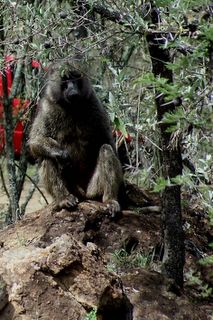 Baboons are a lot of fun and they are very curious. Baboons usually travel in families and don’t seem to mind people (unless we get too close). They’ll even sit by the roadside and sometimes run to cross the street. This guy lives in Hell’s Gate National Park, on the rim of the gorge. He and his family came to see us because they think we have food. They’re very smart.
Baboons are a lot of fun and they are very curious. Baboons usually travel in families and don’t seem to mind people (unless we get too close). They’ll even sit by the roadside and sometimes run to cross the street. This guy lives in Hell’s Gate National Park, on the rim of the gorge. He and his family came to see us because they think we have food. They’re very smart.
Singing and Dancing in Lamu, Kenya
 Here are children in Lamu, on the coast of Kenya, dancing. Their grandfather, Ali Hippy, has invited us to his house for dinner. After dinner, Ali plays the keyboard while his daughters and sons-in-law play drums (using buckets). The music is African and they sing in Kiswahili, the language of the Swahili culture. The young children love to dance to the music. They are also very, very good dancers.
Here are children in Lamu, on the coast of Kenya, dancing. Their grandfather, Ali Hippy, has invited us to his house for dinner. After dinner, Ali plays the keyboard while his daughters and sons-in-law play drums (using buckets). The music is African and they sing in Kiswahili, the language of the Swahili culture. The young children love to dance to the music. They are also very, very good dancers.
Coconut Tree
 Coconuts grow in bunches at the top of the trees. This tree, in Watamu on the coast, is very, very tall. See the notches carved into the side? To get the coconuts, someone will climb up the tree by putting their feet into these carved “steps.” They cut the coconuts and let them drop to the ground.Coconuts are sold on the street. For 10 shillings, about 15 cents US, the seller will slice the top off with a very sharp knife. Once the top is removed, you can drink the clear coconut “milk.” Some people use straws or you can simply drink from the coconut. The nut inside is lined with a soft “meat.” The seller will give you a slice of hard shell to to use like a spoon for scrapping and eating the soft meat. It’s very delicious.
Coconuts grow in bunches at the top of the trees. This tree, in Watamu on the coast, is very, very tall. See the notches carved into the side? To get the coconuts, someone will climb up the tree by putting their feet into these carved “steps.” They cut the coconuts and let them drop to the ground.Coconuts are sold on the street. For 10 shillings, about 15 cents US, the seller will slice the top off with a very sharp knife. Once the top is removed, you can drink the clear coconut “milk.” Some people use straws or you can simply drink from the coconut. The nut inside is lined with a soft “meat.” The seller will give you a slice of hard shell to to use like a spoon for scrapping and eating the soft meat. It’s very delicious.
Artist Market in Kisumu
 This market is where artists bring their handmade goods to sell in Kisumu. They make woven baskets and hand-sewn clothes. Soapstone, a beautiful rock found in the town of Kisii (pronounced Kissy), is dug out of the ground and carved by artists. They make statues, bowls, ashtrays, soap dishes, chess sets and many other things with the stone.
This market is where artists bring their handmade goods to sell in Kisumu. They make woven baskets and hand-sewn clothes. Soapstone, a beautiful rock found in the town of Kisii (pronounced Kissy), is dug out of the ground and carved by artists. They make statues, bowls, ashtrays, soap dishes, chess sets and many other things with the stone.
Many people from other countries buy gifts at this market to take back to their family and friends.
Lake Naivasha Shoreline
 Animals are drawn to Lake Naivasha for water. You'll see flamingos, pelicans, hippos, water bucks and wildebeests close to the lake (and hippos in the lake!). It is very peaceful on Lake Naivasha. This photo shows mountains in the distance and groves of Acacia trees, with animals grazing nearby.
Animals are drawn to Lake Naivasha for water. You'll see flamingos, pelicans, hippos, water bucks and wildebeests close to the lake (and hippos in the lake!). It is very peaceful on Lake Naivasha. This photo shows mountains in the distance and groves of Acacia trees, with animals grazing nearby.
School Boys in Saradidi
 These boys live in Saradidi (pronounced Sara-dee-dee), a small community north of Lake Victoria. You can see the lake from where these boys are standing. They enjoy having their picture made. Afterward, when they see their photo on the digital camera, they giggle and giggle.
These boys live in Saradidi (pronounced Sara-dee-dee), a small community north of Lake Victoria. You can see the lake from where these boys are standing. They enjoy having their picture made. Afterward, when they see their photo on the digital camera, they giggle and giggle.
Children Playing at Secondary School
 This is a schoolyard in Saradidi (pronounced Sara-dee-dee) where girls are playing soccer. They're uniforms are brightly colored. Girls wear skirts and boys wear shorts.
This is a schoolyard in Saradidi (pronounced Sara-dee-dee) where girls are playing soccer. They're uniforms are brightly colored. Girls wear skirts and boys wear shorts.
Malindi Street Scene
 Malindi, a town on Kenya's coast, has a heavy Muslim population. This photo shows a typical street scene of stores and people. Even though Mount Kilimanjaro is about 300 miles away in Tanzania (the country south of Kenya), you can see the name is used all over East Africa. In Malindi, instead of boda bodas (bikes for hire), tuk-tuks (pronounced twok-twoks) are a popular way of getting around town. They are very small cars with three wheels, one in front and two in back. There are now two or three tuk-tuks in Kisumu and we'll probably see more and more here and in other East African countries.
Malindi, a town on Kenya's coast, has a heavy Muslim population. This photo shows a typical street scene of stores and people. Even though Mount Kilimanjaro is about 300 miles away in Tanzania (the country south of Kenya), you can see the name is used all over East Africa. In Malindi, instead of boda bodas (bikes for hire), tuk-tuks (pronounced twok-twoks) are a popular way of getting around town. They are very small cars with three wheels, one in front and two in back. There are now two or three tuk-tuks in Kisumu and we'll probably see more and more here and in other East African countries.
Baby Donkey
Lamu is a city on an island just off the coast of Kenya. It is quiet, beautiful and remote, so few tourists travel there. Most people in Lamu use donkeys to carry their goods. This is because the buildings in Lamu are built very close together, making narrow “streets.” The streets are more like alleys and they twist and turn through the town. It feels like walking in a maze because you cannot see around, over or between the building walls.
Only donkeys can fit in the streets. No cars. In fact, there are only two cars on the island and both belong to the District Officer, a government official who is like the “mayor” of Lamu. The donkey in the photo is a baby and will not have to carry things until he/she is older. In the meantime, baby donkeys run free and usually follow their mothers. Baby donkeys follow their mothers up and down the streets of Lamu while their moms carry bags of potatoes or onions or even bricks.
In Kisumu and other towns in Kenya, men on bicycles will give you a ride for a small fee. A ride from my house to town costs 20 shillings, or about 25 cents US. It's fun to take a boda boda around town, unless they don't have brakes or they're on a road with lots of cars and buses. As you can see from the picture, the bikes have a padded seat on the back and some have handles for the passenger to hold onto just under the driver's seat.
Karen, on the back of the boda boda, is a medical student from Canada, studying to be a doctor, and she is in Kisumu to learn about health care in Kenya. She enjoys taking the boda bodas all over town and especially to the hospital where she works. "Boda Boda" means "border to border," and came from Uganda (the country west of Kenya), where supposedly you can pay a guy to ride you on his bike from one border of the country to the other.
Cats Waiting for Food in Lamu
Cats are given free reign in Lamu. Many people who live on this island are Muslim and are influenced by the Eqyptian belief that cats are some sort of god, or contain the spirit of their ancestors. These cats are especially lucky. If they hang outside this shop long enough, perhaps the owner will share some of his leftover fish and shrimp. The cats are also good for getting rid of unwanted rats.
Mombasa Street Scene
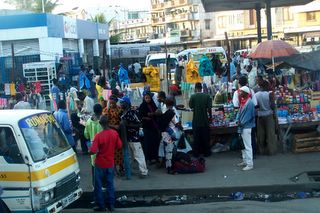 This is a typical street scene in Mombasa, a city on the coast of Kenya. Mombasa is largely Muslim since many Arab people have been coming to the coast of Kenya for centuries. The city also has Indian-spired architecture and food brought by people moving here from India.
This is a typical street scene in Mombasa, a city on the coast of Kenya. Mombasa is largely Muslim since many Arab people have been coming to the coast of Kenya for centuries. The city also has Indian-spired architecture and food brought by people moving here from India.
Camels do not come from Sub-Saharan Africa (The Sahara desert covers a huge portion of North Africa, so all countries south of the Sahara and called "Sub-Saharan"). There are many camels in Kenya, though, brought over from Middle Eastern countries. This camel and his owner/keeper spend time at Kiboko Bay on Lake Victoria. Tourists can pay to ride the camel. Today he is resting, enjoying the breeze off the lake and the cool shade of the tall trees.
Watamu is a very small village on the coast of Kenya. Three lagoons curving into the coast make up the village. Coral grows in these Indian Ocean lagoons and when the tide is out, the coral is exposed. If you walk up to some of the islets (small islands of coral poking up in the lagoon), you see all kinds of beautiful and sometimes scary-looking sea creatures. Mostly crabs. Gray, orange, yellow and white, scurrying, climbing, running. Here is one especially shy crab. Soon the tide will turn, water will fill up the lagoons and this little guy/gal will be safely tucked into the coral, covered by the Indian Ocean.
Football Game by Indian Ocean
Kenya was once a colony of Great Britain, so they have many things you might find in Britain, like European football (soccer). These boys are playing "football" on a field in Malindi, a city on the coast of Kenya. That's the Indian Ocean in the background.
Hasan is a Muslim man, 23-years-old, and he is the captain of this wooden Dhow. A dhow is a handmade boat that has been used by people on Kenya's coast for hundreds of years. Hasan and his shipmate, Jamal, take people on rides through the channels of Kenya's coast. They use the sails to gather wind to move the boat. Otherwise, the boat will sit motionless in the water. By moving the sail from side to side, to capture the wind, Hasan and Jamal keep the boat moving.
In shallow water, they have long, long poles that press to the bottom of the channel, to steer the boat clear of Mangrove trees. They are very good fishermen and usually catch their lunch each day, cooking it on the beach for themselves and their guests. They also love to swim and will dive from the boat to un-snag their fishing lines.
Primary School Sports Day in Kisumu
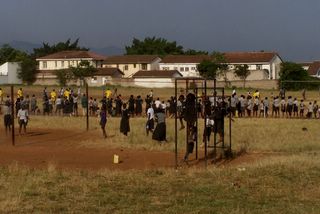 Kids in schools in Kenya play several sports. In this photo, the boys are playing soccer. Nearby, in the same field, boys play volleyball and basketball while the girls climb on the playground equipment. It's hard for girls to play sports in their skirts. Don't you think they should also get to wear shorts so they can run and play?!
Kids in schools in Kenya play several sports. In this photo, the boys are playing soccer. Nearby, in the same field, boys play volleyball and basketball while the girls climb on the playground equipment. It's hard for girls to play sports in their skirts. Don't you think they should also get to wear shorts so they can run and play?!
Spider Web Covered in Morning Dew
 Early in the morning, mist lays across the ground on Lake Naivasha's shores (The lake's name is pronounced "Ni-va-sha."). Lake Naivasha is in central Kenya. Hippos leave the lake at night and stay on the shores until morning, when, very early (around 7:00) they return to the water. On our walk to the shore, dew covers the ground, grass, flowers and even spiderwebs, as you can see from this photo. Soon, when the sun gets a little higher, it will warm the ground and dry up everything, including this spiderweb.
Early in the morning, mist lays across the ground on Lake Naivasha's shores (The lake's name is pronounced "Ni-va-sha."). Lake Naivasha is in central Kenya. Hippos leave the lake at night and stay on the shores until morning, when, very early (around 7:00) they return to the water. On our walk to the shore, dew covers the ground, grass, flowers and even spiderwebs, as you can see from this photo. Soon, when the sun gets a little higher, it will warm the ground and dry up everything, including this spiderweb.
Sikh Indian Children Dancing
 These kids are part of the Asian (Indian) community in Kisumu. In the photo, guests have gathered for a wedding celebration. DJ's play music and everyone dances, including the children. Sometimes they do traditional Indian dances and sometimes they dance like kids in North America. The music is traditional Indian tunes, sang in Kiswahili or Punjabi (from the Punjab region of India) and set to hip-hop rhythms. It's lively and very popular in Kisumu and other parts of East Africa.
These kids are part of the Asian (Indian) community in Kisumu. In the photo, guests have gathered for a wedding celebration. DJ's play music and everyone dances, including the children. Sometimes they do traditional Indian dances and sometimes they dance like kids in North America. The music is traditional Indian tunes, sang in Kiswahili or Punjabi (from the Punjab region of India) and set to hip-hop rhythms. It's lively and very popular in Kisumu and other parts of East Africa.
Children Play Near River Auji
 Lake Victoria is nearby in this photo. The children live in Nyalenda, a slum area of Kisumu, and they walk to the back of their neighborhood to this river, called River Auji (pronounced "ah-oo-gee"). River Auji runs into Lake Victoria about one mile away. Even though the children live so close to these beautiful fields, they are not allowed to play or explore back here because of snakes.
Lake Victoria is nearby in this photo. The children live in Nyalenda, a slum area of Kisumu, and they walk to the back of their neighborhood to this river, called River Auji (pronounced "ah-oo-gee"). River Auji runs into Lake Victoria about one mile away. Even though the children live so close to these beautiful fields, they are not allowed to play or explore back here because of snakes.
Maasai Children in Tanzania
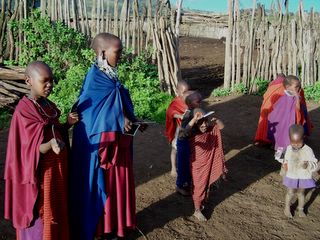 Maasai is a tribe of people who have been in East Africa for hundreds of years. While other tribes have adopted modern ways, like Western style clothes, the Maasai are very traditional. That means they live as their ancestors lived many, many generations ago. Maasai are nomadic, so they move around with their herds of cows and goats to find grass. Maasai people eat mostly meat and live in mud huts. Part of their traditional diet is a dish of cow's blood mixed with milk. For fashion, men and women put holes in their earlobes and enlarge the holes as they grow up. In addition to their bright red and blue wraps, Maasai wear beaded jewelry and ornaments, the men as well as the women.In this photo, we see children who live in a boma, which is a cluster of homes where an extended family lives. The wood fence, made of tree branches, is the pin where the cows and donkeys sleep at night, safe from lions. The children are shaking polaroid pictures of themselves, taken by a friend from New York City.The children go to a school built by their father, Ole Dorop, the chief of this Maasai village. Ole Dorop understands how important it is for the children to get an education. Maasai speak the language Ma. But in school, they also learn to speak Kiswahili and English.
Maasai is a tribe of people who have been in East Africa for hundreds of years. While other tribes have adopted modern ways, like Western style clothes, the Maasai are very traditional. That means they live as their ancestors lived many, many generations ago. Maasai are nomadic, so they move around with their herds of cows and goats to find grass. Maasai people eat mostly meat and live in mud huts. Part of their traditional diet is a dish of cow's blood mixed with milk. For fashion, men and women put holes in their earlobes and enlarge the holes as they grow up. In addition to their bright red and blue wraps, Maasai wear beaded jewelry and ornaments, the men as well as the women.In this photo, we see children who live in a boma, which is a cluster of homes where an extended family lives. The wood fence, made of tree branches, is the pin where the cows and donkeys sleep at night, safe from lions. The children are shaking polaroid pictures of themselves, taken by a friend from New York City.The children go to a school built by their father, Ole Dorop, the chief of this Maasai village. Ole Dorop understands how important it is for the children to get an education. Maasai speak the language Ma. But in school, they also learn to speak Kiswahili and English.
Frankie Wearing Jaime's Hat
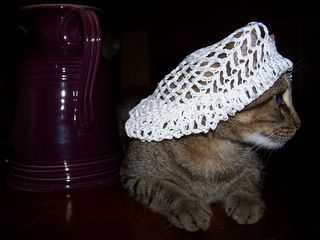 My daughter, Jaime, has a beloved pet, a cat named Frankie. In this photo, taken in Atlanta, Jaime has put a hat on poor Frankie. He doesn't seem to mind. In Kenya and other parts of Africa, cats live outside and kill rats, mice and other critters. They are not usually kept as pets. Dogs are kept in yards as security and it's rare to see them in someone's home as a pet. Often, people do not have enough food to feed their family, so feeding a pet is an additional burden.Do you have a cat, dog, bird or reptile?
My daughter, Jaime, has a beloved pet, a cat named Frankie. In this photo, taken in Atlanta, Jaime has put a hat on poor Frankie. He doesn't seem to mind. In Kenya and other parts of Africa, cats live outside and kill rats, mice and other critters. They are not usually kept as pets. Dogs are kept in yards as security and it's rare to see them in someone's home as a pet. Often, people do not have enough food to feed their family, so feeding a pet is an additional burden.Do you have a cat, dog, bird or reptile?
Warthog: So Ugly He's Cute
 Warthogs are so funny-looking. Little baby warthogs are so funny-looking they're cute. This guys reminds me of the movie “Lion King.” If you've seen that movie, you probably know the song, “Hakuna Matata.” Well, in Kenya and Tanzania, they really do say “Hakuna Matata” to mean “no worries.”
Warthogs are so funny-looking. Little baby warthogs are so funny-looking they're cute. This guys reminds me of the movie “Lion King.” If you've seen that movie, you probably know the song, “Hakuna Matata.” Well, in Kenya and Tanzania, they really do say “Hakuna Matata” to mean “no worries.”
Little Boy in Boat on Lake Victoria Shore
 Lake Victoria is huge. It's the second largest fresh water lake in the world, after Lake Superior in the United States. Remember the great lakes of the United States? Your teacher may have given you the word “HOMES” to help you remember the lakes. Each letter is the first letter of a lake: Huron, Ontario, Michigan, Erie and Superior. In East Africa, we also have a great lakes region. Kenya, Tanzania and Uganda border Lake Victoria. Lake Victoria is the source of the Nile River. As the “source,” waters flow from Lake Victoria north through African countries all the way to Egypt and into the Mediterranean Sea. Fishermen in Lake Victoria catch Nile Perch and Talapia. Hippos also live in the lake. Crocodiles are found around Tanzania and Uganda, but Kenya's portion of Lake Victoria, which is like a very large bay, does not have crocodiles (thank goodness!).The boy in this boat lives near the lake and his father is probably a fisherman. He may grow up to be a fisherman, too. Cows roam around, eating grass, like the one in the picture, and it's possible this boy is in charge of watching over the cow.
Lake Victoria is huge. It's the second largest fresh water lake in the world, after Lake Superior in the United States. Remember the great lakes of the United States? Your teacher may have given you the word “HOMES” to help you remember the lakes. Each letter is the first letter of a lake: Huron, Ontario, Michigan, Erie and Superior. In East Africa, we also have a great lakes region. Kenya, Tanzania and Uganda border Lake Victoria. Lake Victoria is the source of the Nile River. As the “source,” waters flow from Lake Victoria north through African countries all the way to Egypt and into the Mediterranean Sea. Fishermen in Lake Victoria catch Nile Perch and Talapia. Hippos also live in the lake. Crocodiles are found around Tanzania and Uganda, but Kenya's portion of Lake Victoria, which is like a very large bay, does not have crocodiles (thank goodness!).The boy in this boat lives near the lake and his father is probably a fisherman. He may grow up to be a fisherman, too. Cows roam around, eating grass, like the one in the picture, and it's possible this boy is in charge of watching over the cow.
Homemade Wooden Bikes
 Children in African countries usually make their own toys. As you can see from the picture, this bicycle was made by hand and is used to carry water home. Kids seldom play with toys bought from a store. For toy cars, boys construct a vehicle from wire and put bottle-caps on it for wheels. They'll steer the car with a long pole, so they can walk and push the car beside them without bending over. Children also make balls by wading up plastic bags. They make them as small or as large as they like and secure the waded bags in place with rubberbands. They also play with old bicycle tires by keeping the tire up and rolling. The kids use sticks or their hands to push the tire along. One boy had a string tied around his tire so when he pulled the string up, it rolled the tire forward.
Children in African countries usually make their own toys. As you can see from the picture, this bicycle was made by hand and is used to carry water home. Kids seldom play with toys bought from a store. For toy cars, boys construct a vehicle from wire and put bottle-caps on it for wheels. They'll steer the car with a long pole, so they can walk and push the car beside them without bending over. Children also make balls by wading up plastic bags. They make them as small or as large as they like and secure the waded bags in place with rubberbands. They also play with old bicycle tires by keeping the tire up and rolling. The kids use sticks or their hands to push the tire along. One boy had a string tied around his tire so when he pulled the string up, it rolled the tire forward.
Big Turkey Shows Off Tail Feathers
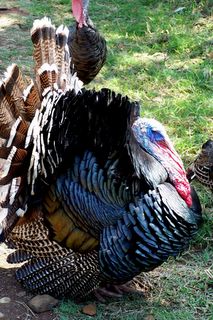 A dirt road leads to the gate of the college where I work. Everyday, I walk to and from work on this dirt road. I pass Maasai warriors who work as security guards at a house on the corner. They wear beautiful red pieces of cloth tied around their waists and wrapped around their shoulders. Because they're warriors, they grow their hair long and braid it. Maasai are usually tall and thin and friendly. I also pass a family of black turkeys every day. Some people are afraid of the turkeys, but they are harmless. They simply walk together, pecking at the ground and occasionally flying up onto walls to move into neighboring yards. This guy likes to puff up his feathers to show how mighty he is. He's lost a tail feather in a fight. Can you see the space where his tail feather used to be?
A dirt road leads to the gate of the college where I work. Everyday, I walk to and from work on this dirt road. I pass Maasai warriors who work as security guards at a house on the corner. They wear beautiful red pieces of cloth tied around their waists and wrapped around their shoulders. Because they're warriors, they grow their hair long and braid it. Maasai are usually tall and thin and friendly. I also pass a family of black turkeys every day. Some people are afraid of the turkeys, but they are harmless. They simply walk together, pecking at the ground and occasionally flying up onto walls to move into neighboring yards. This guy likes to puff up his feathers to show how mighty he is. He's lost a tail feather in a fight. Can you see the space where his tail feather used to be?
Typical Mud House in Rural Kenya
 This house is common in communities throughout Kenya and other East Africa countries. It was made by mixing mud with cow dung to form the walls. Sometimes they use grass to make a thatched roof, but this house has a corrugated tin roof. Usually, the family will place a barrel under the roof edge to catch rain water. The water collected is used for drinking, cooking, bathing and cleaning the house. Drinking water is purified by boiling it over a fire to kill any bacteria that causes sickness. If they don't boil their rain water, they may use a chlorine product, like WaterGuard, to make it safe for drinking.Most rural communities (outside of towns and cities) do not have electricity. The woman who lives in this house uses kerosene lanterns to see inside her house at night. Cows are only penned up at night, to keep wild animals from hurting them, so during the day they roam around and eat grass (or relax in the cool dirt). There are lots of trees and grass in the these country communities, and lots of quiet, until the children return from school!
This house is common in communities throughout Kenya and other East Africa countries. It was made by mixing mud with cow dung to form the walls. Sometimes they use grass to make a thatched roof, but this house has a corrugated tin roof. Usually, the family will place a barrel under the roof edge to catch rain water. The water collected is used for drinking, cooking, bathing and cleaning the house. Drinking water is purified by boiling it over a fire to kill any bacteria that causes sickness. If they don't boil their rain water, they may use a chlorine product, like WaterGuard, to make it safe for drinking.Most rural communities (outside of towns and cities) do not have electricity. The woman who lives in this house uses kerosene lanterns to see inside her house at night. Cows are only penned up at night, to keep wild animals from hurting them, so during the day they roam around and eat grass (or relax in the cool dirt). There are lots of trees and grass in the these country communities, and lots of quiet, until the children return from school!
Chicks Hiding
 These six chicks are hiding beneath their mother. The red hen and her chicks usually live outside, in the yard. But their owner, Betty Mutere, was worried about them getting cold, so she rounded the chicks up and brought them indoors, which they are not used to.
These six chicks are hiding beneath their mother. The red hen and her chicks usually live outside, in the yard. But their owner, Betty Mutere, was worried about them getting cold, so she rounded the chicks up and brought them indoors, which they are not used to.
I was there the day Betty, Karen (from Canada) and Betty's five children chased the chicks, trying to catch them. I was trying to catch a chick or two, also, but they're sooooo fast!! It took us 30 minutes of crawling through bushes on our knees to gather the chicks into a rubber bucket. They're fine now and have been returned to the yard, where they run and play, staying close to their mother.







































